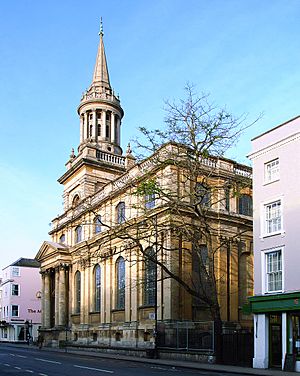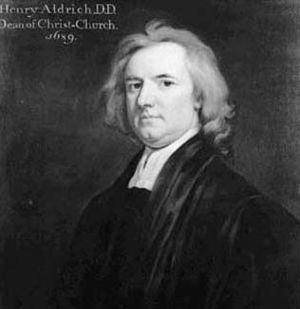All Saints Church, Oxford facts for kids
Quick facts for kids All Saints |
|
|---|---|
| All Saints Church | |

|
|
| Location | Turl Street, Oxford |
| Country | United Kingdom |
| Denomination | Anglican |
| Website | www.lincoln.ox.ac.uk |
| Architecture | |
| Style | English Baroque |
| Years built | 1720 |
| Administration | |
| Diocese | Oxford |
All Saints Church is a historic building in central Oxford, England. You can find it on the north side of the High Street, right where it meets Turl Street. This building used to be a church, but now it's the main library for Lincoln College. It's considered a very important historical building, known as a Grade I listed site.
Contents
A Look Back: The Church's History
The very first All Saints Church was built on this spot way back in 1122. That's almost 900 years ago!
A New Beginning after a Collapse
Sadly, on March 8, 1700, the tall, pointed top part of the church, called the spire, fell down. This accident destroyed most of the building. People quickly started raising money to rebuild it. The church you see today was finished in 1720. It was big enough to seat about 350 people.
The main design for the new church was created by Henry Aldrich, who was the head of Christ Church college. It's believed that Nicholas Hawksmoor designed the tower and spire. Luckily, four of the church's original bells survived the collapse. Rebuilding the church was very expensive. Many colleges from the University of Oxford helped by donating money. Even Queen Anne, who was the Queen at the time, contributed funds.
Becoming the City Church
In 1896, another church in Oxford, St Martin's Church, was mostly taken down. After that, All Saints Church became the official "City Church." This meant that the Mayor and other city officials were expected to attend services there.
In 1946, a special Union Jack flag was placed in the church. This flag had been used to cover the coffins of prisoners of war in Borneo. Two wooden plaques were also placed there to remember them. These items were later moved to Dorchester Abbey.
From Church to Library
In 1971, All Saints Church was no longer needed as a church. This is called being "declared redundant." The role of the City Church then moved to St Michael at the North Gate. All Saints was then "deconsecrated," which means it was no longer used for religious purposes.
After this, the building was offered to Lincoln College, which is right next to the church. Starting in 1975, after some changes, the building became Lincoln College's library.
The College Library Today
When the church was turned into a library, the biggest change inside was raising the floor. The original floor was lifted by more than four feet. This created space for more reading rooms underneath.
Reading Rooms and Important Names
The upper reading room is now called the Cohen Room. It has a beautiful ceiling with fancy plaster designs. You can also see shields of the important people who gave money to rebuild the church in the 1700s.
The lower reading room is where the science books are kept. It also holds older, more valuable books. The science section is named after Howard Florey (1898–1968). He was a professor at Lincoln College and played a huge part in developing penicillin, a very important medicine.
The Church Bells
Even though it's a library now, the building still has a full set of eight bells. These bells are regularly rung by the Oxford Society of Change Ringers. This group was started in 1734. The bells are also rung for special events, like when a new head of the college, called a Rector, is chosen.
Another All Saints Church

There is another church called All Saints Church in the area of Headington. This is a suburb located east of central Oxford, on Lime Walk. This other All Saints Church was officially opened in 1910.
Gallery
-
A view of All Saints Church from the west, looking along the High Street.
-
All Saints Church as seen from St Mary's Church, also on the High Street.
See also
 In Spanish: All Saints Church para niños
In Spanish: All Saints Church para niños





